Cooler Master Silencio S600 - Quiet and Stylish
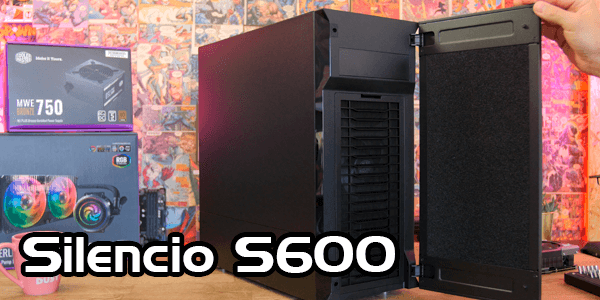
At this year’s Computex, Cooler Master revealed a range of new cases, and among these were some new additions to their Silencio series, which we last saw introduced back in 2011. The new additions include the Silencio S400 and S600, and it’s the latter of the two that we’re going to have a look at today. The S400 is a smaller version targeted at Micro ATX motherboards, while the S600 is meant for full size ATX motherboards.
Cooler Master’s purpose with the Silencio series is, as they themselves explain, to strike a good balance between noise cancellation, temperature and price.
The Silencio S600 arrives at retailers with a price tag of $99.99.
Watch our video review of the Silencio S600 on our YouTube channel (Danish).
From the very first moment it’s very clear that Cooler Master has aimed for a very minimalistic expression with the S600. The case is, more or less, simply a black box without any unnecessary bells and whistles. This is a design that surely will appeal to most people.
Should you, however, find pleasure in a bit more bling, there’s the option of a tempered glass side panel. But if you prefer as much sound dampening as possible, the steel side panel is the way to go.
For this test, we’ve been provided with both options, but do keep in mind that you have to decide between the two before ordering your’s.
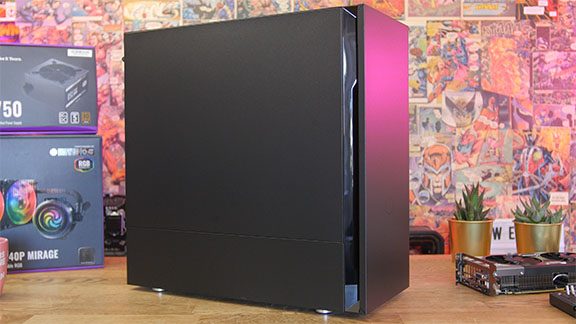
The left side panel does not occupy the entire surface of the side of the case. There’s a separate chamber at the basement, where the power supply is installed.
The side panels are very easy to attach, and come with fixed thumb screws that prevents them getting lost. The steel side panels are heavy, due to the material, but also because of the interior padding of sound dampening material. It’s a tightly compressed rubber material with a fabric surface, and it feels exceptionally dense.
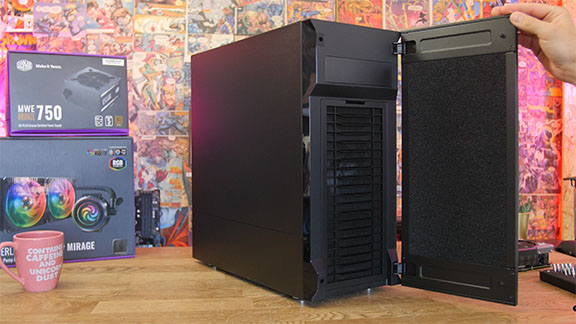
The front of the S600 from Cooler Master can be opened, and on the inside of the panel you find the same sound dampening material. There’s also the option to swap the hinges so that you basically can decide to which side the front door opens.
There’s a dust filter on the front, which can easily be removed and cleaned, and similarly can be added back on with ease. It supports up to two 120 mm or 140 mm fans at the front, behind the dust filter.
The Silencio S600 also supports the installation of an optical drive at the top of the case. This can, however, be removed in case you prefer having room for other devices.
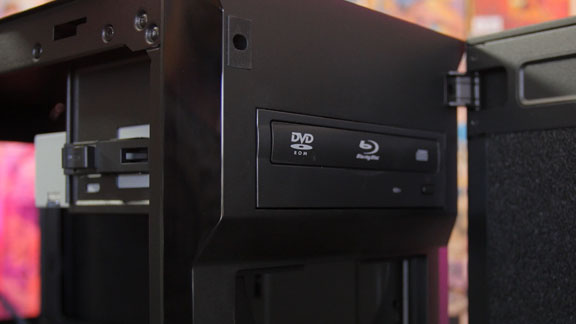
It would even be possible to install yet another fan at the top, if you’d be so inclined, but it would be a funny setup since it would only be screwed in at the bottom, and it would be partly covered by the plastic panel that would otherwise have been the opening for the optical drive. Also, the top fan would not be covered by the front dust filter.
In our view, it would be less than ideal, but on the other hand, we prefer being given the choice and not use it than the opposite of that.
With the door closed, there’s openings of 12 mm on both sides of the front.
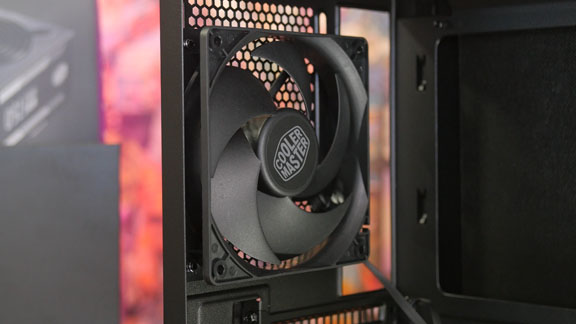
We get two Cooler Master Silencio FP120 fans, where one is installed in the front, and one on the rear of the case. There’s room for an additional two 120 mm or 140 mm fans at the top of the Silencio case.
However, the case is by default equipped with a sound dampening panel on the top that features more of the same material as seen in other places of this case. So, if you want to use this area for additional cooling, a magnetic dust filter is also included, which can be used at the top instead.
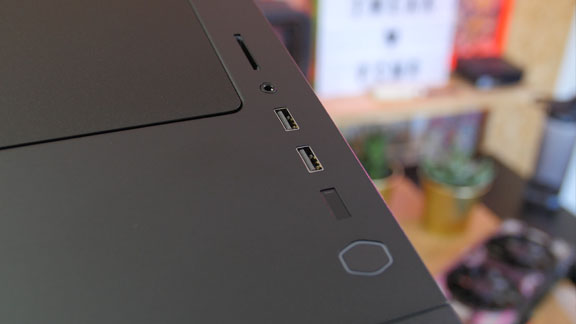
At the top of the Silencio case, we find the power and reset buttons, along with two USB 3.2 Gen 1 ports and a 3.5 mm audio jack for both audio in and out. In addition, we also find an SD card reader similar to that of the first Silencio cases. This is quite useful when the case is used for an office workstation, which is one of the segments that Cooler Master is actually targeting with this case.
If we move on to the interior layout, we find that we’re dealing with a typical chambered layout. In this case, it means that the power supply, cables and drive bays are hidden at the bottom of the case. So, on that note, Cooler Master has not reinvented the wheel or made any new initiatives in order to dampen noise.
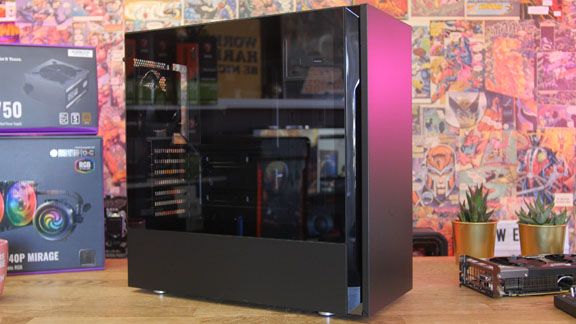
There’s room for motherboard formats up to ATX size, and depending on what you install at the front, the case will support graphics cards with a length of 398 mm and CPU coolers at a height of 166 mm, if you use the sound dampening steel panel, and 167 mm if you use the tempered glass panel.
There are good cable routing options, but only some of them feature rubber grommets, which only really matters if you use the tempered glass side panel allowing one to look into the case.
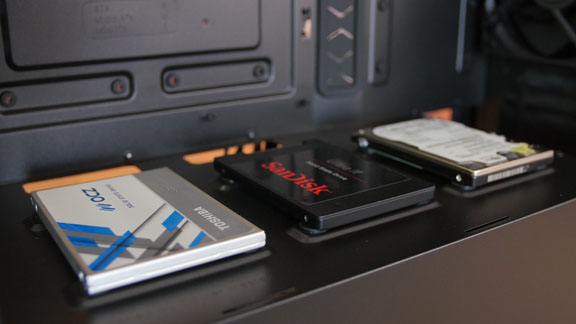
There are lots of options for installing 2.5-inch SSDs in the Silencio from Cooler Master. Three of which are located in the bottom of the main chamber and an additional two on the backside of the motherboard. They all feature a tool-free design with rubber brackets - common to Cooler Master cases.
On the backside there’s also support for a 3.5-inch mechanical drive in the same fashion.
Alternatively, one can install three drives at the bottom, in a different, but easy, way, in which you attach brackets to the sides of the drive, and then slide it into a holder.
It’s easy and practical, but also means that you cannot install 2.5-inch SSDs instead, in case you’d prefer that. However, with the already provided number of 2.5-inch drive bays of the Silencio S600 we don’t expect this to become an issue for many people.
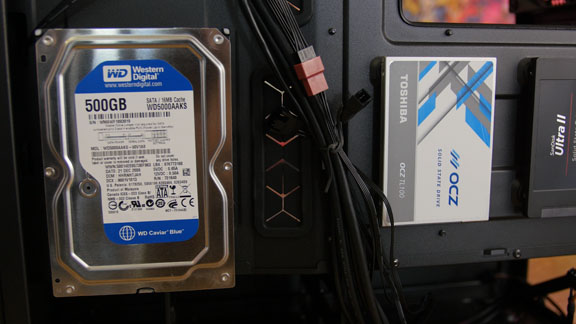
Unfortunately, the drive cage in the bottom of the case cannot be removed, in case you do not intend to use it. We’d prefer it to have been removable. This might limit the available space a bit, in case you have a longer power supply, and it oddly goes against the otherwise modular approach common of Cooler Master.
The building-process with this case was straightforward and problem-free, given that this is a completely standard layout. Also, there’s plenty of room in the case for both the hardware, but also to route the cables out of sight on the backside.
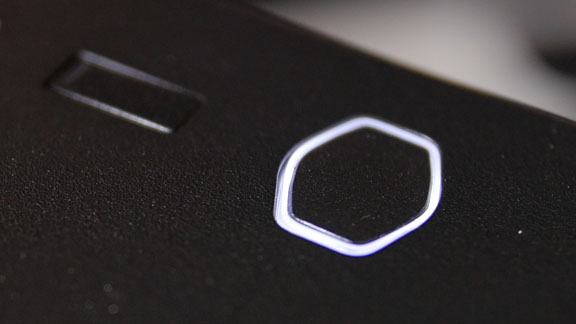
This is without doubt the most quiet system that we’ve built in a long time. Usually, cases are more flashy, but it’s actually nice to see a more quiet and subtle system without any bling or a cascade of colors.
If you have the glass side panel it naturally puts your hard-earned components on display, and then a bit of lights will appear in the darkness, but this can of course be deactivated in case you want a more low-key look, or you can simply opt for hardware with a minimum of RGB implemented.
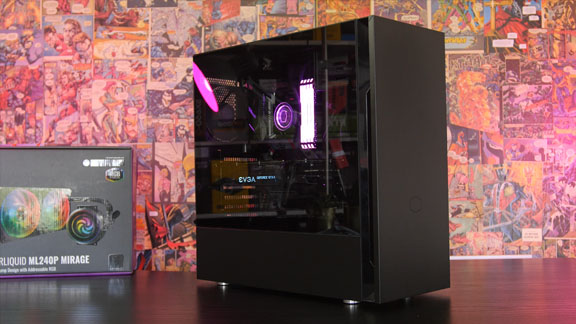
A nice little detail that we didn’t notice until the build process was the inclusion of a PWM splitter cable that will allow for up to three fans to be connected to a single PWM connector on the motherboard and then control them as one.
It’s a welcome minor feature that will make it much easier to control the fans.
The finished system is nice to behold, and especially so, if you appreciate a more quiet and subtle look that doesn’t stand out too much with all the colors of the rainbow.
The only light that can be seen is the dim white light around the power button. The button is shaped like the logo of Cooler Master, and together with the subtle logo also printed on the front, they comprise the only indication that we’re dealing with a case from Cooler Master.
In terms of performance, we’ve focused mainly on noise level and airflow, and here, we find that the Silencio S600 achieves a good balance.
You won’t get a completely silent case if you at the same time want a system with top notch hardware. This will require a good airflow, and fans are, at the end of the day, not completely silent.
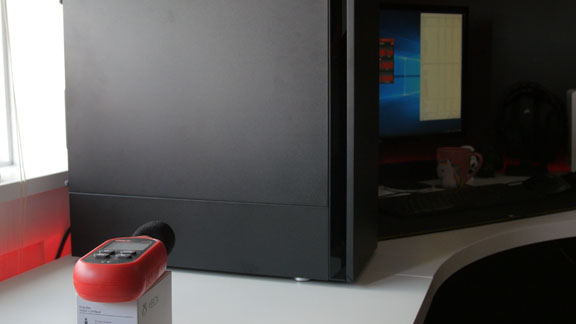
We measured the noise level of the system, and with no load we measured around 36,5 dBA when situated 40 cm from the case. A humming can easily be noted coming from the case, but it’s at such a low frequency that it isn’t penetrating or irritating and it will quite easily be drowned out by music or just a plain conversation.
If you open the front or take off the sides there’s a substantial increase in the noise level. As such, we can conclude that the sound dampening material does a top mark performance.
In addition, the good news here is that the noise level doesn’t increase much under full load. Here, we reach around 37 dBA with the steel side panel that has sound dampening material. If we exchange this to the tempered glass side panel we noted only a small increase on our measuring device. At no point did the noise level bother us.
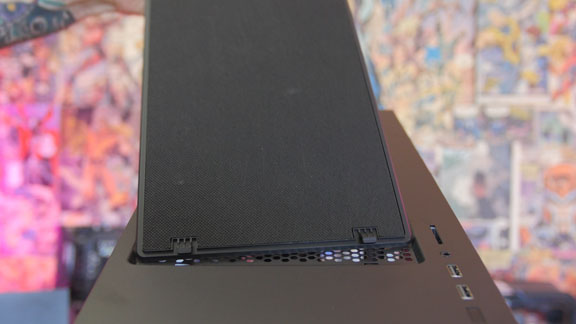
We ended up with a CPU temperature that topped at 76 °C with a Cooler Master MasterLiquid ML240P Mirage cooler, which had been provided by Cooler Master along with the case. So, there’s a reasonable amount of airflow inside the case that isn’t held back by the sound dampening features.
Overall, we find that the Silencio S600 case from Cooler Master provides a solid starting point for a silent system. It should be added, though, that a silent case will only take you some way towards a silent system.

The hardware that is installed inside the case needs to be similarly optimized or else it will be an uphill journey, even with the most sound optimized case on the market.
According to Cooler Master, the price sits at $99.99. At that price, we find that the Silencio S600 is an excellent purchase. Cooler Master manages well to strike a good balance between noise level, airflow and price.
We would have liked a better solution to the drive cage at the bottom of the case, as well as around the optical drive at the front, but these are minor things that we don’t consider severe enough to influence the overall impression of a well-constructed case at that price.
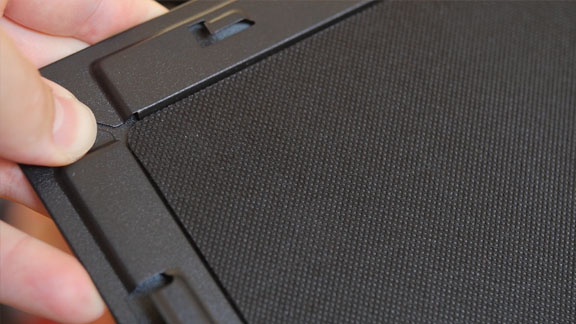
We arrive at a final score of 8 and the Safe Buy Award for a case that does its job really well and at a good price. It targets those of us that don’t necessarily need to be bathed in a glory of rainbow colors when situated in front of our computer.
Pros
Good sound dampening materials
Built-in SD card reader
Good SSD and HDD installation
Cons
Lack of flexibility in certain areas
Fixed 3.5-inch cage at the bottom


Latest computer case
-
15 Jancomputer case
-
06 Jancomputer case
be quiet! Light Base 900FX
-
13 Deccomputer case
Be quiet! Pure base 501 Airflow
-
26 Novcomputer case
XPG is ready with a new case and magnetic fan
-
18 Sepcomputer case
Fractal Design Era 2
-
21 Juncomputer case
Fractal Design Mood
-
07 Juncomputer case
BeQuiet ready with new cabinets at Computex
-
06 Juncomputer case
New cases from Fractal Design at Computex
Most read computer case
Latest computer case
-
15 Jancomputer case
Be quiet! Light Base 600 LX
-
06 Jancomputer case
be quiet! Light Base 900FX
-
13 Deccomputer case
Be quiet! Pure base 501 Airflow
-
26 Novcomputer case
XPG is ready with a new case and magnetic fan
-
18 Sepcomputer case
Fractal Design Era 2
-
21 Juncomputer case
Fractal Design Mood
-
07 Juncomputer case
BeQuiet ready with new cabinets at Computex
-
06 Juncomputer case
New cases from Fractal Design at Computex






